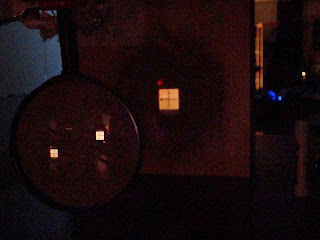Object distance (d_o, cm) | Image distance (d_i, cm) | Object height (h_o, cm) | Image height (h_i, cm) | Magnification | Type of Image |
100 | 26.5 | 3 | 0.8 | 0.266 | Inverted |
80 | 28.5 | 3 | 1 | 0.333 | Inverted |
60 | 32 | 3 | 1.5 | 0.5 | Inverted |
40 | 43.5 | 3 | 3.5 | 1.16 | Inverted |
30 | 71 | 3 | 6.7 | 2.23 | Inverted |
We found that in every case the image was inverted, but when be placed the object within the focal distance no image could be seen. Only when you looked though the lens could you see an image in the lens. To describe the relationship between image distance and object distance we took the inverse of d_i and plotted it against the negative inverse of d_o. We then obtain the following graph.
This graph illustrates that the equation 1/d_o + 1/d_i = 1/f. However this graph shows that the focal length of our lens to actually be 20.9 cm long. This is a percent difference of 6.6% which is in a reasonable percent error when considering the error that went into this experiment. If we wished to decrease the percent error we could have used more accurate measuring equipment and have used a different method when it came to measuring the focal length of our lens.

No comments:
Post a Comment